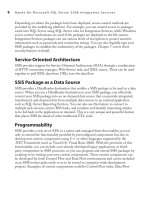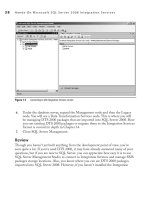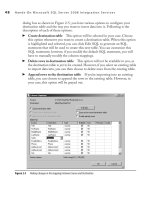Hands-On Microsoft SQL Server 2008 Integration Services part 5 pps
Bạn đang xem bản rút gọn của tài liệu. Xem và tải ngay bản đầy đủ của tài liệu tại đây (200.2 KB, 10 trang )
18 Hands-On Microsoft SQL Server 2008 Integration Services
Integration Services Architecture
Now you understand the benefits Integration Services provides, with its vast array of
features, and also know about various versions and feature sets associated with them.
Before we move further and get our hands dirty by starting working with it, it’s time
to know its architecture. Once you understand its architecture, you will be able to
appreciate how the various components perform their jobs to successfully execute an
Integration Services package. Let’s start with the architecture diagram provided in
Microsoft SQL Server 2005 Books Online and shown in Figure 1-1.
Custom applications SSIS designer
Integration
services
service
SSIS wizards
Native
Object model
Integration services runtime
.dtsx file
msdb
database
Enumerators
Container
Connection
managers
Event
handlers
Task
Task
Task
Task
Task
Data flow task
Data Flow Task
Object model
Integration services data flow
Source
Transformation
Transformation
Destination
Data flow
components
Custom
data flow
components
Destination
Source
Package
Managed
Command line utilities
Tasks
Custom
tasks
Log
providers
Data
sources
Figure 1-1 Integration Services architecture
Chapter 1: Introducing SQL Server Integration Services 19
Microsoft SQL Server 2008 Integration Services consists of the following four main
components:
Integration Services service
c
Integration Services object model c
Integration Services run-time engine c
Integration Services data flow engine c
Well, you’ve read little bit about these components earlier in this chapter as you were
going through the features and uses of Integration Services. The following discussion
on each of these components and their functions will clarify how Integration Services is
architected.
Integration Services Service
Shown on the top-right corner of the architecture diagram (Figure 1-1), the Integration
Services service is installed as a Windows service when you specifically choose Integration
Services during installation. In the next section’s Hands-On exercise, you will see where
you make this choice and learn that choosing Integration Services specifically during
installations installs other components as well. The Integration Services service allows
you to execute Integration Services packages on local or remote computers, stop
execution of running packages on local or remote computers, monitor running packages
on local or remote computers, and connect to multiple Integration Services servers to
manage multiple instances. In Figure 1-1, the Integration Services service points to a
.dtsx file and MSDB database, implying that this service can manage SSIS packages
stored to a file system or in an MSDB database within SQL Server 2008. The service
manages SSIS packages by importing and exporting them from one type of storage
location to another. You will learn a lot more about managing packages and their storage
locations in Chapter 6.
You can connect to the Integration Services service using that SQL Server Management
Studio, as you will do later in this chapter. Generally, with other software components,
if the service is stopped, most of the components stop working. This is not true with
Integration Services, because it is a component used to monitor running packages and
manage their storage. You do not need to have this service running to design and run a
package. You can save the newly designed package in BIDS on to the file system or in the
SQL Server 2008 MSDB database and then execute it as well. However, you may find it
a bit faster when running the Integration Services service, as it caches the metadata of the
package and the connections. Also, if you need to monitor and list the packages using the
SQL Server Management Studio, the Integration Services service must be running.
20 Hands-On Microsoft SQL Server 2008 Integration Services
Integration Services Object Model
As mentioned earlier, Integration Services is a new product with an object model
that supports both native and managed APIs. You can easily use this object model
to write custom components such as tasks and transformations using C++ or any
common language runtime (CLR)–compliant language. This object model provides
easy accessibility for Integration Services tools, command-line utilities, and custom
applications as shown on the top section of Figure 1-1. You can also develop custom
components, build new packages, load and modify existing packages, and then execute
them programmatically. This enables you to automate maintenance and execution
of your packages completely. Programming Integration Services is a vast subject and
deserves a separate book altogether. A complete discussion is beyond the scope of
this book.
Integration Services Run Time
The Integration Services run time provides support for the package, containers, tasks,
and event handlers during package execution. It also provides run-time services such
as support for logging, breakpoints, connections to data sources and data stores, and
transactions. You read earlier that Integration Services has two separate engines: a run-
time engine for workflow and another engine for data flow. Basically, the Integration
Services run time consists of whatever you configure in the Control Flow tab of BIDS
plus the run-time services.
Integration Services Data Flow
As mentioned, the second engine of Integration Services provides services to the data
flow within a package. This data flow is also known as the pipeline due to the nature of
data flowing through various transformations one after another. The Data Flow Task
is a unique task provided in the Control Flow tab of BIDS that encapsulates the data
flow engine and the data flow components. Integration Services Data Flow consists
of one or many Data Flow Sources; none, one, or many Data Flow Transformations;
and one or more Data Flow Destinations. The Data Flow engine drives the data out
of Data Flow Sources, brings it into pipeline, and lets the Data Flow Transformations
perform the aggregations and conversions, merge data streams, conditionally split data
into multiple streams, perform lookups, derive columns, and perform several other
operations before loading the data into the destination data stores using Data Flow
Destinations. You will work with Data Flow components in Chapters 9 and 10 in
much detail.
Chapter 1: Introducing SQL Server Integration Services 21
Installing Integration Services
Now is the time to move forward and get our hands dirty by installing Integration
Services. But take a few more minutes before we do that to learn about the installation
options and the implications of these options. In real life, either you will be installing
Integration Services on a clean Windows platform—that is, a system where no current or
previous releases of SQL Server are installed—or you will be installing it on a computer
that already has SQL Server 2005 Integration Services or Data Transformation Services
of SQL Server 2000 installed. You may choose to install SQL Server 2008 Integration
Services alongside SQL Server 2005 Integration Services or DTS 2000, or you may
choose to upgrade the existing version of SSIS 2005 or DTS 2000. All these options and
their implications have been discussed in the following sections.
Installing Integration Services on a Clean System
Most of the production systems are built using this method. Administrators prefer to
install SQL Server on a fresh installation of a Windows server to avoid any debugging
later on because of some old component on the server that doesn’t work properly with
SQL Server 2008 Integration Services. I recommend you use a sandbox for doing the
Hands-On and install Integration Services clean so that you don’t struggle initially with
unwanted issues of compatibility or coexistence. You can install Integration Services
either by using the SQL Server Installation Wizard or by running setup program from
the command prompt.
You’ll install Integration Services using the SQL Server Installation Wizard in
the following Hands-On exercise. You will be installing SQL Server 2008 database
engine and Integration Services together in this exercise; however, note that Integration
Services does not require SQL Server in order to work. You can develop packages in
Integration Services that connect to mainframes, Oracle or DB2 database servers, and
output in flat files without installing SQL Server. A couple of high-end transformations
such as the Fuzzy Lookup Transformation and Fuzzy Grouping Transformation
need to create temporary tables for processing data in SQL Server and hence require
connection to an SQL Server. However, even in this case, you do not need to have SQL
Server running on the same local machine where your Integration Services package
is designed or executed. Having said that, Integration Services is a fairly independent
product and does not require SQL Server to operate; however, installing the SQL
Server Database on the same server might prove beneficial, as most SSIS packages need
to be run as SQL Server Agent jobs, which is a database engine feature.
22 Hands-On Microsoft SQL Server 2008 Integration Services
Hands-On: Installing SQL Server 2008
Integration Services
This is your first Hands-On in which you will install SQL Server 2008 Integration
Services using the SQL Server Installation Wizard on a clean system.
Method
It is important that you follow this process step-by-step, as this installation will be
used throughout this book to create and run Integration Services projects. If you do
not have SQL Server 2008 Enterprise Edition or Development Edition software, you
can download the SQL Server 2008 Enterprise Evaluation Edition from Microsoft’s
download web site. This version is valid for 180 days and can be used for trial purposes.
Details on non–Integration Services installation options are not covered here and are
beyond the scope of this book. Refer to Microsoft SQL Server 2008 Books Online for
more details on these installation options.
Exercise (Running the SQL Server Installation Wizard)
Load SQL Server 2008 DVD media in your computer’s DVD drive and start the
installation as follows:
1. After you load the DVD, the Autorun feature will open the Start screen, which
displays various options. If Autorun doesn’t do this, browse the DVD and run
setup.exe from the root folder. Click the Installation hyperlink from the left
sidebar and choose a new SQL Server stand-alone installation or else choose to
add features to an existing installation to start the installation.
2. Setup first installs the .NET Framework 3.5 SP1 if it is not already installed.
Some versions of Windows Server may require different versions of .NET
Framework. Accept the License Agreement and click Install. The Installation
Wizard will install .NET Framework, the SQL Server Native Client, and setup
support files. Once installation completes, click Exit and the setup installs
hot fixes for the operating system if it needs any. Click Finish to complete the
preinstallation phase; it may require a restart to continue installation. After restart,
again run setup.exe from the installation DVD and choose the New SQL Server
installation link.
3. The installation program performs Setup Support Rules checks and lists pass,
failure, and warning messages. Click OK to proceed further. On the Setup
Support Files screen, click Install to install the required setup support files.
4. On the Feature Selection screen, choose Database Engine Services from the
Instance Features section, choose Business Intelligence Development Studio,
Integration Services, Client Tools Backwards Compatibility, Client Tools SDK,
Chapter 1: Introducing SQL Server Integration Services 23
SQL Server Books Online, and Management Tools—Complete from the Shared
Features section as shown in Figure 1-2.
This is the most important step in the installation process, as you choose to
install Integration Services here. However, even if you do not specifically select
Integration Services to install, some components of Integration Services will still
be installed because of they are needed to perform specific functions for other
selected components. For example, the SQL Server Import and Export Wizard
will be installed when you install SQL Server Database Services only. Also,
most of the tasks and transformations will be available to you for developing
your packages when you install Business Intelligence Development Studio
without selecting Integration Services. Bear in mind that Integration Services
is not required for developing and executing packages within BIDS; however,
to run packages outside the development environment, you do need to choose
Integration Services specifically at this step. Integration Services is installed as a
Windows service and helps to manage storage of SSIS packages in SQL Server
Figure 1-2 Feature Selection for Integration Services
24 Hands-On Microsoft SQL Server 2008 Integration Services
or the file system using SQL Server Management Studio and enables you to
monitor running packages in local as well as remote SSIS instances. Another
benefit of installing Integration Services service is that it caches metadata of
package components and speeds up loading of packages in Business Intelligence
Development Studio. Selecting Integration Service also installs the ActiveX
Script task and the DTS Package Migration Wizard.
Also, note that the Integration Services is not listed under Instance Features
section. This means that you cannot install more than one instance of Integration
Services. Though you don’t have multiple instances of Integration Services on the
server, it is instance aware. That is, it can connect to any instance of SQL Server
and is not tied to a particular SQL Server instance. All you have to do is modify
the Integration Services Configuration file to connect to a different SQL Server
instance to store packages. More on this topic is covered in Chapter 6 of the book.
As mentioned earlier, Business Intelligence Development Studio is the designing
tool for your packages, and selecting this installs the 32-bit design environment
along with most of the tasks and transformations. Management Tools installs
SQL Server Management Studio and is used to connect to Integration Services,
manage storage of packages in the MSDB database and the file system, and
monitor running packages.
Selecting Client Tools Backward Compatibility feature installs legacy support
components and the Execute DTS 2000 Package task to enable you to run your
DTS 2000 packages inside the Integration Services 2008 package. If you want the
DTS 2000 run-time environment to be installed, you must install it separately.
Chapter 14 covers more details on this subject. The Client Tools SDK will be
required to install custom-developed managed assemblies for Integration Services,
and finally, SQL Server Books Online is the documentation installation feature.
Select Shared Feature Directory and click Next.
5. Confirm that on the Instance Configuration page, Default Instance is selected
and MESQLSERVER is specified in the Instance ID. Click Next. Again click
Next to confirm the Disk Space Requirements.
6. Specify Account Name and password in the Server Configuration page. By
default, Integration Service installs with NT AUTHORITY\NETWORK
SERVICE account. It is recommended that you choose an appropriate domain
account with minimum required permissions assigned. Proceed next to the
Database Engine Configuration page to choose an authentication mode. Choose
Mixed Mode and specify a password for the built-in system administrator
account. Click Add Current User to add yourself to the administrators group and
click Next three times to reach to Ready To Install page.
7. Review the options on the Ready To Install screen and press Install when ready.
Chapter 1: Introducing SQL Server Integration Services 25
8. You will see the installation of SQL Server 2008 components in the Installation
Progress screen. This may take about 15 to 30 minutes to complete on a fast machine.
9. When the process completes, you will see the installation summary log in the
Complete screen. Click Close to close the Installation Wizard. If prompted,
restart your computer to complete the installation process.
Review
You installed the SQL Server 2008 database engine default instance and SQL
Server Integration Services in the preceding exercise. In real life, you’ll be installing
Integration Services on 64-bit servers, as they are becoming more affordable and
prevalent these days. Note that the 64-bit version of SQL Server 2008 software
installs all the 64-bit components by default. However, BIDS is a 32-bit development
environment for Integration Services and selecting this feature installs a 32-bit version
of Integration Services tools, enabling you to run your packages in 32-bit mode on a
64-bit server. Also, BIDS is not supported on the 64-bit Itanium operating system
and hence is not installed on Itanium servers. You can now check the programs that
have been installed via the Control Panel. Also, open the Services console from the
Administrative Tools and note the SQL Server 2008 services have been installed along
with SQL Server Integration Services 10.0 service. Now you can play around with the
software components installed by the Installation Wizard in the Programs group to
make yourself acquainted with various components if you haven’t had a chance to look
at SQL Server 2008 up until now.
Installing Integration Services
from the Command Prompt
Command prompt installation can help you roll out Installation to a team, install multiple
nodes of a failover cluster, or use scripted installation files as a backup plan in case the
worst happens. You can install the Integration Services by executing setup.exe along
with parameters from the command prompt on a local or remote server. The parameters
and their values can be specified either directly in the command or by use of an .ini file.
The parameter-value pairs that are relevant for installing Integration Services and its
components using a command prompt are as follows:
Action
c is is a required parameter that specifies the installation type—install,
upgrade, or repair. See Books Online for more parameter values.
Features
c Indicates the SQL Server components to be installed, for instance,
(SQL) for Database Engine, (IS) for Integration Services. Other options are (AS)
for Analysis Services, (RS) for Reporting Services, and (Tools) for client tools.
26 Hands-On Microsoft SQL Server 2008 Integration Services
ISSVCAccount c is is a required parameter option that specifies the service
account for the Integration Services service.
ISSVCPassword
c Specify a password for the ISSVCAccount using this option.
ISSVCStartupType c is is an optional parameter to specify the startup type for
the service: automatic, manual, or disabled.
For example, if you want to install the SQL Server Database Engine, Integration
Services, and client tools and online documentation, the syntax for the command will
be something like this:
setup.exe /q /ACTION=install /FEATURES=IS /ISSVCACCOUNT="DomainName\
UserName" /ISSVCPASSWORD="StrongPassword"
To know about more available options, refer to Microsoft SQL Server 2008 Books
Online.
Installing Side by Side
If you already have SQL Server 2005 Integration Services or SQL Server 2000 Data
Transformation Services installed on a computer and don’t want to remove or upgrade
them, you can still install SQL Server 2008 Integration Services alongside them. They
all can coexist on the same computer because all three have different execution and
design environments. You may wonder, but in fact the SQL Server 2008 Integration
Services has a different designer than its predecessor; for instance, BIDS in 2008 is
built on a different architecture than BIDS 2005. Though they can coexist, there
are some considerations for you to keep in mind when you’re working with multiple
versions of Integration Services.
SQL Server 2008 Integration Services has been optimized for performance over its
previous version, SSIS 2005. While doing that, the development team at Microsoft has
also made some underlying changes such as replacing the word “dts” with “ssis” from
several places. As you can expect, this will mean that the code Integration Services
works with in the 2005 version will most likely not work in the 2008 version. One such
change affects storage of SSIS packages in SQL Server. The sysdtspackages90 table
used in SQL Server 2005 to store packages in the MSDB database has been changed
to the sysssispackages table in SQL Server 2008. It isn’t hard to imagine that an
Integration Services version won’t be able to access packages across both versions due to
different storage tables.
This also means that you cannot store packages in the MSDB database of one version
that have been developed in another version of Integration Services. You must stick to
the same version to open and modify packages using Business Intelligence Development
Chapter 1: Introducing SQL Server Integration Services 27
Studio. To clarify a bit more, we have a new version of Business Intelligence Development
Studio in SQL Server 2008, which is based on Visual Studio 2008. BIDS also has a
new scripting environment built around Visual Studio Tools for Applications (VSTA),
replacing the earlier environment of Visual Studio for Applications (VSA) used in
BIDS 2005. These underlying changes enable you to install BIDS 2008 side by side
with BIDS 2005. However, this leaves BIDS 2008 unable to save packages in SSIS
2005 format. You can load and run packages in BIDS 2008 that have been developed
in BIDS 2005; however, loading BIDS 2008 converts these packages into SSIS 2008
format and hence runs the package in 2008 environment. You can save this package in
SSIS 2008 format but not in SSIS 2005. Hence if you want to modify your SSIS 2005
packages and want to keep them in 2005 format, you have to use BIDS 2005.
On the other hand, BIDS 2005 cannot load the higher version—i.e., SSIS 2008,
packages at all. For similar reasons, you have a new version of the dtexec utility. While
dtexec can run both SSIS 2008 and SSIS 2005 packages, it actually executes only SSIS
2008 format packages, as it converts SSIS 2005 packages temporarily to SSIS 2008
format before execution. This means that if your SSIS 2005 package can’t be converted
to SSIS 2008 format by dtexec, it can’t be run. So, you must be a bit careful when
working with the packages, as it may require you to keep multiple versions of the same
package for SSIS 2005 and SSIS 2008.
On the other hand, things are rather simple, as Integration Services can coexist with
DTS 2000 without any issues and there are no interoperability, issues as they are totally
different in usability, operability, and many other respects. While Integration Services
provides wizards and tools to migrate from DTS 2000 to its latest version, it still offers
run-time support to run DTS 2000 packages as is. The Execute DTS 2000 Package task
allows you to run a DTS 2000 package inside an Integration Services package. This task
is not installed by default; you must choose the Client Tools Backward Compatibility
feature during the Integration Services installation process.
Upgrading to SQL Server 2008 Integration Services
You can upgrade from SQL Server 2000 Data Transformation Services or SQL
Server 2005 Integration Services. Both the Installation Wizard and the command
prompt installation provides options to upgrade. With the Installation Wizard, select
the Upgrade from SQL Server 2000 or SQL Server 2005 option, but for a command
prompt installation, specify the /ACTION=upgrade option in the parameters.
When upgrading SQL Server 2005 Integration Services, you can upgrade either
Database Engine and Integration Services together or just the Integration Services or
just the Database Engine. The easiest option is to upgrade both Database Engine and
Integration Services together when both are on the same computer. This option offers
the fewest issues after upgrade, as the MSDB tables that store packages, metadata, and









